Subscribe to our ▶️ YouTube channel 🔴 for the latest videos, updates, and tips.
Addition of Like Fractions
To add two or more like fractions we simplify add their numerators. The denominator remains same.
1. Let us find the sum of two fractions \(\frac{3}{7}\) and \(\frac{2}{7}\).
\(\frac{3}{7}\) is colored green.
\(\frac{2}{7}\) is colored yellow.
\(\frac{3}{7}\) + \(\frac{2}{7}\) is represented by
\(\frac{3}{7}\) + \(\frac{2}{7}\)
= \(\frac{3 + 2}{7}\)
= \(\frac{5}{7}\) = \(\frac{\textrm{Sum of Numerators}}{\textrm{Common Denominator}}\)
Addition of Like Fractions Video
Subscribe to our ▶️ YouTube channel 🔴 for the latest videos, updates, and tips.
Addition of Fractions with the Same (Like) Denominator
2. Observe the following figures:
What do we observe?
In the first figure \(\frac{1}{4}\)of the circle is shaded and in the second figure \(\frac{2}{4}\) of the circle is shaded.
In all, we have Hence 3/4 of the circle is shaded.
\(\frac{1}{4}\) + \(\frac{2}{4}\) = \(\frac{1 + 2}{4}\) = \(\frac{3}{4}\)
Thus, to add the fractions with the same denominator, we simply add their numerators and write the common denominator.
Sum of the fractions with like denominators = \(\frac{\textrm{Sum of the Numerators}}{\textrm{Common Denominator}}\)
Solved Examples on Addition of Like Fractions:
1. Find the sum of \(\frac{1}{9}\) and \(\frac{4}{9}\).
Solution:
Sum of \(\frac{1}{9}\) and \(\frac{4}{9}\)
= \(\frac{1}{9}\) + \(\frac{4}{9}\)
= \(\frac{1 + 4}{9}\)
= \(\frac{5}{9}\)
2. Find the sum of \(\frac{7}{27}\) and \(\frac{9}{27}\).
Solution:
Sum of \(\frac{7}{27}\) and \(\frac{9}{27}\)
= \(\frac{7}{27}\) + \(\frac{9}{27}\)
= \(\frac{7 + 9}{27}\)
= \(\frac{16}{27}\)
3. Find the sum of \(\frac{4}{29}\), \(\frac{5}{29}\) and \(\frac{8}{29}\).
Solution:
Sum of \(\frac{4}{29}\), \(\frac{5}{29}\) and \(\frac{8}{29}\).
= \(\frac{4}{29}\) + \(\frac{5}{29}\) + \(\frac{8}{29}\)
= \(\frac{4 + 5 + 8}{29}\)
= \(\frac{17}{29}\)
More Examples on Addition of Like Fractions:
(Fractions having same denominator)
4. Add \(\frac{5}{17}\) + \(\frac{4}{17}\)
Solution:
\(\frac{5}{17}\) + \(\frac{4}{17}\)
= \(\frac{5 + 4}{17}\)
= \(\frac{9}{17}\) (in lowest terms)
5. Add \(\frac{3}{23}\) + \(\frac{13}{23}\) + \(\frac{4}{23}\)
Solution:
\(\frac{3}{23}\) + \(\frac{13}{23}\) + \(\frac{4}{23}\)
= \(\frac{3 + 13 + 4}{23}\)
= \(\frac{20}{23}\) (in lowest terms)
Addition of Three Like Fractions Video
Subscribe to our ▶️ YouTube channel 🔴 for the latest videos, updates, and tips.
6. Find the sum of \(\frac{31}{105}\), \(\frac{41}{105}\) and \(\frac{11}{105}\).
Solution:
Sum of \(\frac{31}{105}\), \(\frac{41}{105}\) and \(\frac{11}{105}\).
= \(\frac{31}{105}\) + \(\frac{41}{105}\) + \(\frac{11}{105}\).
= \(\frac{31 + 41 + 11}{105}\)
= \(\frac{83}{105}\)
7. Find the sum of \(\frac{3}{7}\) and \(\frac{2}{7}\)
Solution:
\(\frac{3}{7}\) + \(\frac{2}{7}\) = \(\frac{3 + 2}{7}\) = \(\frac{5}{7}\)
2. Find the sum of \(\frac{1}{15}\), \(\frac{4}{15}\), \(\frac{7}{15}\)
Solution:
\(\frac{1}{15}\) + \(\frac{4}{15}\) + \(\frac{7}{15}\) = \(\frac{1 + 4 + 7}{15}\) = \(\frac{12}{15}\)
Worksheet on Addition of Like Fractions:
1. Add the following Like Fractions:
(i) \(\frac{2}{5}\) + \(\frac{3}{5}\)
(ii) \(\frac{1}{8}\) + \(\frac{3}{8}\) + \(\frac{7}{8}\)
(iii) \(\frac{11}{23}\) + \(\frac{10}{23}\) + \(\frac{5}{23}\)
(iv) \(\frac{2}{10}\) + \(\frac{1}{10}\) + \(\frac{3}{10}\)
(v) \(\frac{5}{11}\) + \(\frac{7}{11}\) + \(\frac{4}{11}\) + \(\frac{2}{11}\)
Answer:
1. (i) 1
(ii) 1\(\frac{3}{8}\)
(iii) 1\(\frac{3}{23}\)
(iv) \(\frac{3}{5}\)
(v) 1\(\frac{7}{11}\)
2. Find the sum:
(i) \(\frac{1}{9}\) + \(\frac{4}{9}\)
(ii) \(\frac{1}{4}\) + \(\frac{2}{4}\)
(iii) \(\frac{5}{21}\) + \(\frac{8}{21}\)
(iv) \(\frac{4}{15}\) + \(\frac{7}{15}\)
(v) \(\frac{7}{16}\) + \(\frac{8}{16}\)
(vi) \(\frac{13}{19}\) + \(\frac{2}{19}\)
Answer:
2. (i) \(\frac{5}{9}\)
(ii) \(\frac{3}{4}\)
(iii) \(\frac{13}{21}\)
(iv) \(\frac{11}{15}\)
(v) \(\frac{15}{16}\)
(vi) \(\frac{15}{19}\)
3. Using the figures, fill in the blanks:
|
(i) |
\(\frac{1}{8}\) + \(\frac{2}{8}\) = \(\frac{--- + ---}{8}\) = \(\frac{---}{8}\) | |
|
(ii) |
\(\frac{1}{5}\) + \(\frac{2}{5}\) = \(\frac{--- + ---}{5}\) = \(\frac{---}{5}\) | |
|
(iii) |
\(\frac{1}{8}\) + \(\frac{2}{8}\) + \(\frac{2}{8}\) = \(\frac{--- + --- + ---}{8}\) = \(\frac{---}{8}\) | |
|
(iv) |
|
\(\frac{2}{7}\) + \(\frac{4}{7}\) = \(\frac{--- + ---}{7}\) = \(\frac{---}{7}\) |
4th Grade Math Activities
From Addition of Like Fractions to HOME PAGE
Didn't find what you were looking for? Or want to know more information about Math Only Math. Use this Google Search to find what you need.



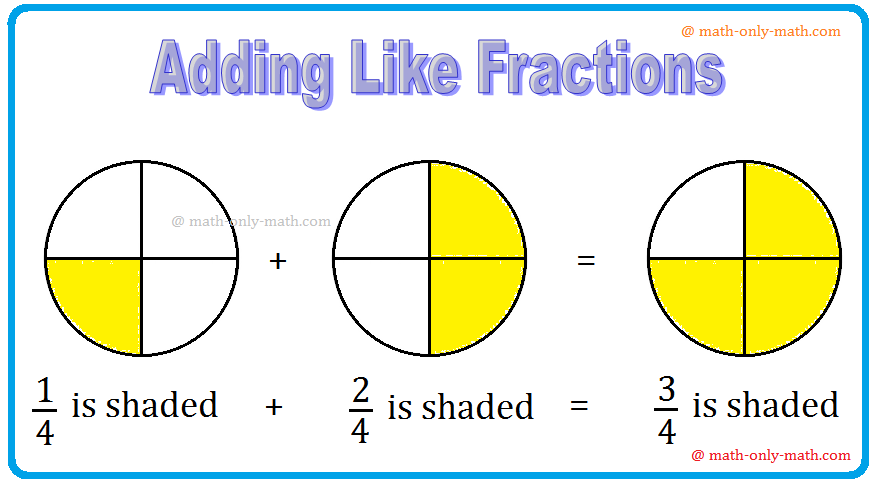
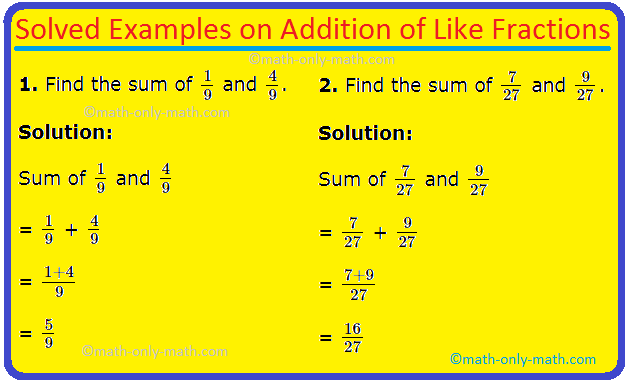
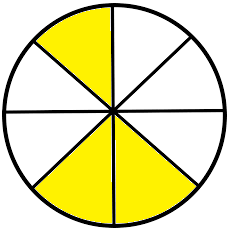
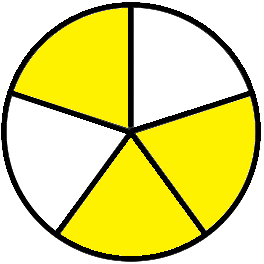
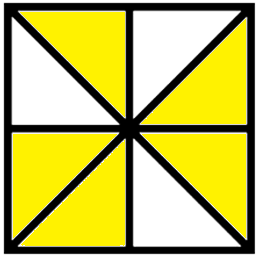

![To convert a percentage into a fraction, place the given number over 100 and reduce it to its lowest term. Consider the following example: (i) 20% [We know % = 1/100]](/image-thumbnails/convert-a-percentage-into-a-fraction.png/default.webp)














New! Comments
Have your say about what you just read! Leave me a comment in the box below. Ask a Question or Answer a Question.